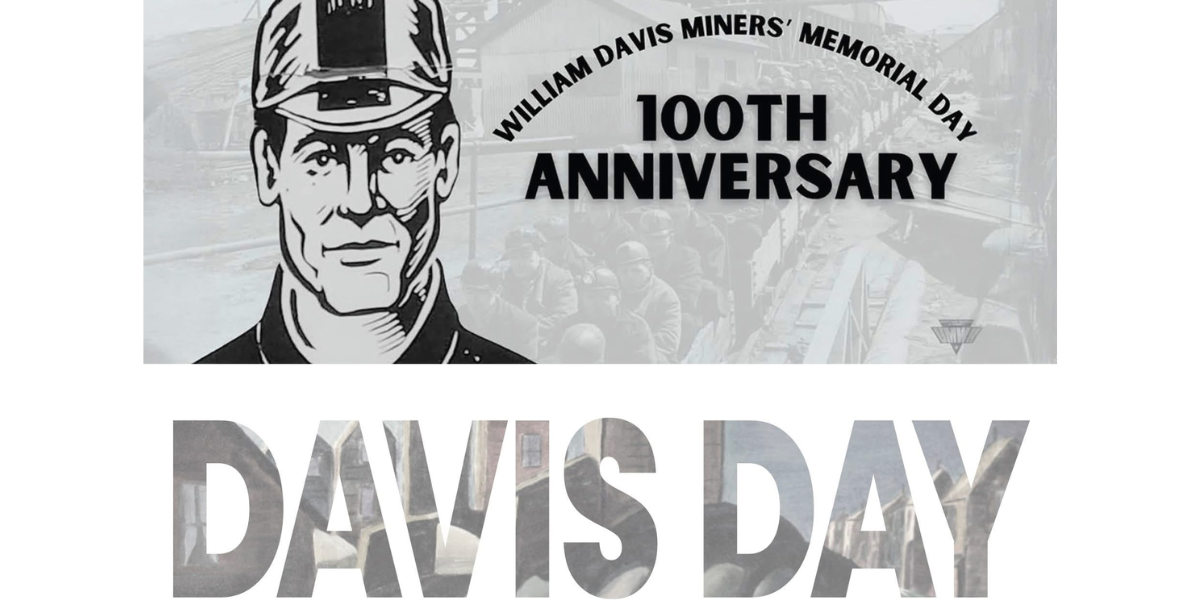One hundred years ago, on June 11, 1925, company police gunned down William “Bill” Davis, a 37-year-old unionized coal miner and father of nine, in the woods near Waterford Lake outside New Waterford, Cape Breton while he was participating in a march of striking coal miners. This week marks the 100th anniversary of William Davis Miners’ Memorial Day (“Davis Day”) in the historic coal mining communities of Cape Breton and northern Nova Scotia.
The murder of William Davis by company police during the mine workers strike became a rallying cry for workers across Nova Scotia and beyond, transforming Davis Day into one of the most enduring symbols of working-class resistance in Canadian history. As we mark the centennial of this pivotal moment in Cape Breton’s labour history, it’s crucial to understand not just the tragic circumstances of Davis’s death, but the broader militant tradition of Cape Breton’s coal miners that continues to inspire today’s labour organizers and union members in the region and across Canada.
The crucible of Industrial Cape Breton
The brutal conditions faced by coal miners in the mine pits of mining communities such as New Waterford and Glace Bay shaped Cape Breton’s coal mining communities in the early 20th century.
Davis himself was no stranger to the industry’s deadly toll. His older brother, Thomas, had been killed at age 14 in the catastrophic Springhill mine explosion of 1891.
Born in Gloucestershire, England, on June 3, 1887, Davis immigrated to Nova Scotia and began working for the Dominion Coal Company Limited in 1905, eventually becoming a skilled pumpman and roadmaker at the No. 12 Colliery in New Waterford.
The corporate landscape shifted dramatically in 1920 when the mines were absorbed by the British Empire Steel Corporation (BESCO), a Montreal-based conglomerate infamous for its financial manipulation and ruthless anti-union policies. BESCO embarked on a systematic campaign to destroy the United Mine Workers of America (UMWA) District 26, which had successfully organized Cape Breton’s 14,000 coal miners.
The company’s strategy was as simple as it was vicious: starve the miners into submission. When the union’s contract expired on January 15, 1925, BESCO refused to negotiate and on March 2 cut off credit at company stores in areas of strong union militancy. This wasn’t merely an economic pressure tactic. In company towns where miners often had no alternative sources of food and supplies, this was a weapon of mass starvation aimed at women and children.
The 1925 strike: A battle for survival
Four days after the credit cutoff, nearly 12,000 miners walked off the job, beginning what would become one of the most brutal and sustained class conflicts in Canadian history.
BESCO Vice-President John Ernest McLurg’s arrogant dismissal of the strike revealed the company’s class contempt. “Poker game, nothing, we have all the cards… Let them stay out two months or six months, it matters not; eventually they will have to come to us… They can’t stand the gaff”
That phrase, ”standing the gaff,” would become the miners’ defiant battle cry. Later it would be immortalized on William Davis’s memorial monument in New Waterford.
For months, thousands of Cape Breton families faced genuine starvation as BESCO maintained its blockade. The company’s refusal to accept arbitration and its escalating use of private police forces demonstrated the lengths to which capital would go to crush organized labour.
The situation reached a boiling point in early June of 1925 when UMWA District 26 implemented full out picketing of all of the mine pits.
On June 4, 1925, miners occupied the Waterford Lake power plant, which supplied electricity to New Waterford and surrounding communities. In response, BESCO police forcibly expelled the miners and, in an act of collective punishment reminiscent of siege warfare, cut off electricity and water to the entire town of New Waterford, including the hospital where critically ill children lay in grave danger.
The murder of William Davis
The events of June 11, 1925, represent one of the darkest chapters in Canadian labour history. That morning, mounted BESCO company police conducted a provocative patrol through New Waterford, terrorizing women and children in what can only be described as psychological warfare.
William Davis’s daughter Alma later recalled scraping her knees as she fled from “drunken bums in police uniforms” chasing children through the schoolyard.
Enraged by this assault on their community, miners held a mass meeting and decided to march to Waterford Lake to demand restoration of power and water services. Estimates of the crowd ranged from 700 to 3,000 people, including men, women, and children driven to desperation by months of corporate warfare against their basic survival.
Contemporary accounts suggest Davis was not initially planning to join the march. According to family history, he was borrowing milk for his youngest child when he discovered his two oldest sons, Jim and Tom, were among the protesters. Like any father, he joined the crowd to protect his children from danger; a tragic irony given what followed.
When the unarmed crowd reached the power plant clearing, approximately 100 BESCO and provincial police officers were waiting, armed and ready for confrontation. Before the miners could even state their case, the police charged, firing over 300 shots into the crowd.
The attack lasted less than fifteen minutes but left a devastating toll: Gilbert Watson shot in the stomach, Michael O’Handley trampled by horses, John MacQuarrie shot in the wrist, Barney Ryan shot through the arm, Bart Conchu with a bullet wound to the head, and William (Bill) Davis shot through the heart.
Witness testimony from the coroner’s inquest reveals the cold-blooded nature of Davis’s murder. George Durdle, standing just six feet from Davis, testified that a policeman deliberately aimed his weapon at them. Neil MacKinnon saw the fatal shot fired by mounted officer Joseph MacLeod from close range. Multiple witnesses confirmed that Davis was unarmed, carrying nothing but a baby bottle of milk in his shirt pocket.
The birth and evolution of Davis Day
William Davis received “the largest funeral ever seen in New Waterford” on June 14, 1925, with an estimated 5,000 mourners attending. But his death marked a beginning rather than an end.
At a union convention held by the UMWA District 26 later that year, June 11 was declared “Davis Day.” Miners vowed never again to work on June 11, fully closing all mine pits throughout Cape Breton and in mining communities of norther Nova Scotia such as Springhill each and every year for the past one hundred years.
The early observances reflected the raw grief and anger of the mining communities. In former industrial Cape Breton towns like New Waterford, Glace Bay, and Sydney Mines, government offices, banks, town halls, and schools shut down completely for the day. The tradition included ecumenical religious services, wreath-laying ceremonies at Davis’s grave in Scotchtown, and visits to the Miners’ Monument.
Still, to this day, one hundred years later, schools in Cape Breton’s historic mining communities close each year for at least a half day on June 11 in commemoration of Davis Day.
Over the decades, Davis Day has evolved to encompass broader themes of workers’ solidarity and mining heritage, in addition to a platform to raise issues of health and safety in the mine pits and other workplaces.
The 1938 expansion of the observance to include all miners killed in UMWA District 26 mines reflected both the ongoing dangers of the industry and the fading of specific memories related to the 1925 strike. This evolution reminds us how working-class communities adapt their commemorative practices to maintain relevance across generations while preserving essential political messages.
Attendance at Davis Day ceremonies has fluctuated dramatically over the years, often reflecting broader political and economic conditions.
J.B. McLachlan: The revolutionary conscience of UMWA District 26 and Cape Breton Coal Miners
No discussion of this period would be complete without examining the towering figure of James Bryson (J.B.) McLachlan, whose revolutionary leadership shaped the militant character of Cape Breton’s labour movement.
Born in Scotland in 1869, J.B. McLachlan migrated to Nova Scotia in 1902 and quickly emerged as the charismatic Secretary-Treasurer of the UMWA District 26 in Cape Breton.
McLachlan’s approach to labour organizing went far beyond simple trade unionism. A devoted reader despite limited formal education, he brought a sophisticated analysis of class struggle that drew from both evangelical Christianity and revolutionary socialism.
His tombstone in Glace Bay bears the Old Testament inscription: “Open thy mouth, judge righteously, and plead the cause of the poor and needy,” a perfect summation of his life’s work.
During the 1920s strikes, McLachlan demonstrated remarkable organizational skills and tactical innovation. His “ardent activism led to him being barred from the mines, but that didn’t stop him from toiling on behalf of miners.” Through publications like the Maritime Labour Herald and the Nova Scotia Miner, he articulated a working-class perspective that challenged both corporate power and government complicity.
McLachlan’s influence extended beyond immediate workplace issues to embrace broader questions of political economy. His early recruitment to the Communist Party of Canada (CPC), whose membership in the 1920’s included many Cape Breton coal miners and steel workers, proved “centrally important in forging what would become enduring political links with rank-and-file militants.”
A monument to McLachlan was erected in Glace Bay, Cape Breton in 1992. On one side his image is paired with McLachlan’s words:
“I believe in education for action. I believe in telling children the truth about the history of the world. That it does not consist of the history of kings, or lords or cabinets. It consists of the history of the mass of the workers. A thing that is not taught in the schools. I believe in telling children how to measure value. A thing that is not taught in any school.”
The back side of the memorial has the text of the poem “Away, False Teachings of My Youth” by working-class Cape Breton poet Dawn Fraser. The poem appeared in the Maritime Labour Herald newspaper edited and published by McLachlan and makes this tribute to him:
So, let us warn the nation’s youth that it’s a crime to speak the truth; they made the law to fit the case, to lead McLachlan to disgrace. So crucify him on a cross because he dared to sass the boss, because he had the guts to tell the company to go to hell.”
Lessons for today’s labour movement
Davis Day ceremonies continue across Nova Scotia’s former coal mining communities, though the format has adapted to changing circumstances. While some mining towns once closed completely for the day, many now observe only half-day closures for schools, reflecting both the decline of the coal industry and the weakening of militant trade unionism in Cape Breton and throughout Nova Scotia.
However, the core message of Davis Day remains powerfully relevant. As the Nova Scotia Federation of Labour noted in its 2024 statement, “Davis Day is more than just a historical commemoration; it is a day to acknowledge the enduring spirit of solidarity and resilience among workers.”
In an era of increasing corporate power, precarious employment, and attacks on collective bargaining rights, William Davis’s sacrifice resonates with contemporary struggles for workplace dignity and economic justice.
This 100th anniversary of the murder of Bill Davis is an opportunity to reflect and honour the sacrifices made for workers’ rights in general, in addition to commemorating the police murder of William Davis specifically. The expanded ceremonies in both New Waterford, Cape Breton and Springhill in northern Nova Scotia demonstrate how Davis Day continues to serve as a focal point for labour solidarity across Nova Scotia, connecting historical memory to present-day organizing efforts.
Davis descendants like Norma Woods MacDonald and Anita Davis have advocated for returning to full-day Davis Day holiday observances on June 11, arguing that this would better honor the historical significance of their ancestor’s sacrifice. Their perspective reflects a broader tension within the labour movement about how to maintain militant traditions in an increasingly hostile political environment.
The legacy of William Davis and the militant traditions of Cape Breton’s coal miners offer crucial lessons for contemporary labour organizers. First, the 1925 strike demonstrates the lengths to which employers will go to destroy worker organization, including the use of private police forces and collective punishment of entire communities. The current resurgence of corporate anti-union campaigns, from Amazon warehouses to Starbucks coffee shops, shows that these tactics remain central to capitalist strategy.
Second, the role of community solidarity in sustaining long-term resistance cannot be overstated. The Cape Breton miners’ ability to maintain their strike for months despite genuine starvation reflected deep bonds between workplace and community organization. Today’s labour movement must rebuild these connections, recognizing that worker power depends on broader social solidarity.
Third, the revolutionary vision articulated by leaders like J.B. McLachlan remains essential for transcending narrow business unionism. McLachlan’s combination of immediate workplace organizing with broader political analysis provided a framework for understanding labour struggles as part of larger conflicts over social power.
Contemporary unions that limit themselves to purely economic demands miss opportunities to build the kind of transformative movement that Cape Breton’s miners represented.
Finally, the evolution of Davis Day itself illustrates how working-class memory can serve both commemorative and organizing functions. The challenge for today’s labour movement is to create new traditions and practices that honor past struggles while mobilizing current generations of workers.
Standing the Gaff
As we mark the centennial of William Davis’s murder, his legacy calls us to recommit ourselves to the militant traditions that built the labour movement.
Davis wasn’t a professional organizer or political leader. He was a working father trying to protect his children and community from corporate violence. His transformation into a symbol of working-class resistance demonstrates how ordinary people become extraordinary through their willingness to stand up to power.
The phrase “standing the gaff,” originally used by BESCO executives to mock workers’ ability to endure hardship, has become a badge of honor for generations of Cape Breton miners and their families. Today, as working people face new forms of economic violence and political repression, we must reclaim that spirit of defiant resistance.
William Davis died so that future generations of workers might live with dignity. Our task is to ensure his sacrifice was not in vain.
Davis Day reminds us that the struggle for workers’ rights is never finished, that each generation must be prepared to defend and extend the gains won by previous struggles. In honoring William Davis, we commit ourselves to building the kind of militant, class-conscious labour movement that can challenge corporate power and create a more just society.
As the old union song says: “We have fed you all for a thousand years, and you hail us still unfed.”
The fight continues.
Full schedule of events for the William Davis Miners’ Memorial Day (“Davis Day”) 100th Anniversary commemorative events in New Waterford, Cape Breton on Wednesday, June 11th:
10:00 a.m. – William Davis Memorial Service
Calvin United Church
420 Hudson Street, New Waterford, NS
11:00 a.m. – Wreath Ceremony & Special Guest Speakers
Davis Square, Mining Memorial
3453 Baker Avenue, New Waterford, NS
12:00 p.m. – Lunch Reception
Army, Navy & Air Force Veterans Unit 217
495 Smith Street, New Waterford, NS
6:00pm to 8:00pm. – “A Night of Song & Speech In Honour of the Centennial of the Death of William Davis”
Café Marie • Eltuek Arts Centre
170 George Street, Sydney, NS
Did you like this article? Help us produce more like it by donating $1, $2, or $5. Donate



